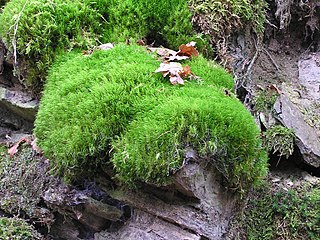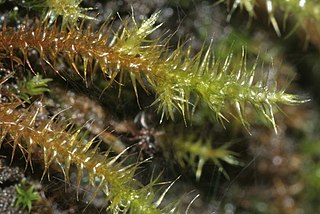
Polygonum is a genus of about 130 species of flowering plant in the buckwheat and knotweed family Polygonaceae. Common names include knotweed and knotgrass. In the Middle English glossary of herbs Alphita, it was known as ars-smerte. There have been various opinions about how broadly the genus should be defined. For example, buckwheat has sometimes been included in the genus as Polygonum fagopyrum. Former genera such as Polygonella have been subsumed into Polygonum; other genera have been split off.

Jungermanniaceae is the namesake family of leafy liverworts. It is a group of small plants that are widely distributed. Several genera formerly included within the family are now classified in the Myliaceae or Solenostomataceae.

Lepidoziaceae is a family of leafy liverworts. It is a group of small plants that are widely distributed.
Kurzia is a genus of liverworts in the family Lepidoziaceae. It contains the following species. Kurzia crenacanthoideaG. Martens is a synonym of Kurzia gonyotricha(Sande Lac.) Grolle.

Hypnaceae is a large family of moss with broad worldwide occurrence in the class Bryopsida, subclass Bryidae and order Hypnales. Genera include Hypnum, Phyllodon, and Taxiphyllum.

Dicranaceae is a family of haplolepideous mosses (Dicranidae) in class Bryopsida. Species within this family are dioicous. Genera in this family include Dicranum, Dicranoloma, and Mitrobryum.

Lophoziaceae is a family of liverworts belonging to the order Jungermanniales.

Grimmia is a genus of mosses (Bryophyta), originally named by Jakob Friedrich Ehrhart in honour of Johann Friedrich Carl Grimm, a physician and botanist from Gotha, Germany.

Cephaloziaceae is a family of liverworts.

Schistidium is a plant genus in the moss family Grimmiaceae.

Amblystegiaceae is a family of mosses. It includes 20 to 30 genera with a total of up to 150 species. They occur nearly worldwide, growing in tropical, temperate, and subpolar regions.

The Flora of Lord Auckland and Campbell's Islands is a description of the plants discovered in those islands during the Ross expedition written by Joseph Dalton Hooker and published by Reeve Brothers in London between 1843 and 1845. Hooker sailed on HMS Erebus as assistant surgeon. It was the first in a series of four Floras in the Flora Antarctica, the others being the Flora of Fuegia, the Falklands, Kerguellen's land, etc (1845–1847), the Flora Novae-Zelandiae (1851–53), and the Flora Tasmaniae (1853–59). They were "splendidly" illustrated by Walter Hood Fitch.

Syntrichia is a large, cosmopolitan genus of mosses in the family Pottiaceae. The genus name is of Greek origin for "plus" and "hair", referring to the "twisted peristome united by a basal membrane".
Barbilophozia attenuata is a species of liverwort belonging to the family Anastrophyllaceae.
Gymnocolea is a genus of liverworts belonging to the family Anastrophyllaceae.
Anastrophyllaceae is a family of liverworts belonging to the order Jungermanniales.

Cephaloziellaceae is a family of liverworts belonging to the order Jungermanniales.
Lophocoleaceae is a family of liverworts belonging to the order Jungermanniales.













